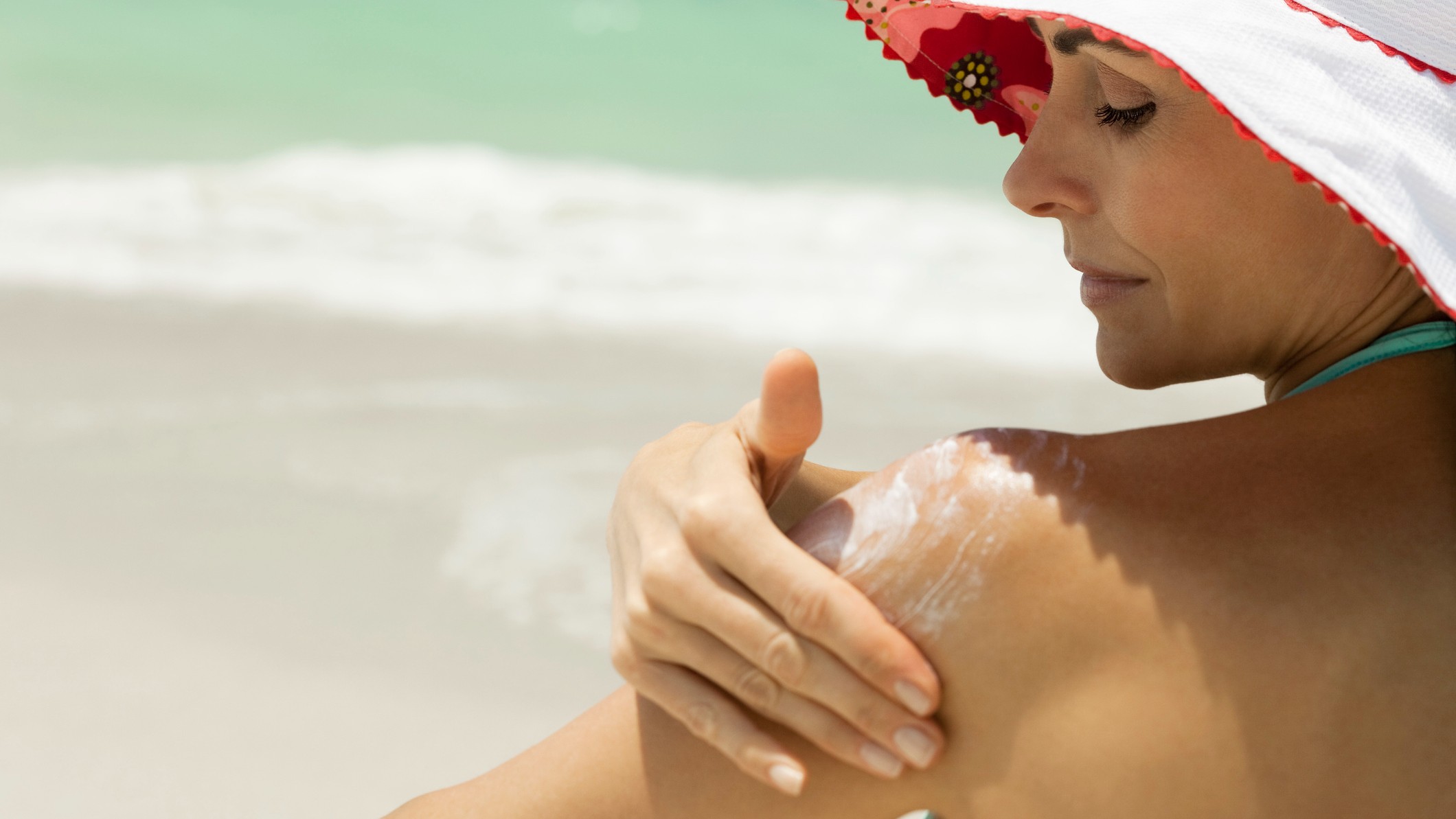
Experts agree that sunscreen — whether it's a spray, lotion, gel or wax — is an essential part of daily skin care. As a first line of defense against sunburn, sunscreen protects skin cells from DNA damage that can drive premature aging of the skin and the development of skin cancer, according to the Skin Cancer Foundation (SCF).
But how does sunscreen work? Here, we take a deep look at how specific sunscreen ingredients contribute to sun protection.
What is in sunscreen?
Ultraviolet A (UVA) and ultraviolet B (UVB) rays are types of light that fall between visible light and X-rays on the electromagnetic spectrum; both types of UV radiation are produced by the sun and by tanning beds. Human eyes cannot see these rays, as they have shorter wavelengths than visible light does, according to the SCF.
Sunscreen products are made up of a mix of chemicals that prevent UV radiation from burning the skin. However, not all sunscreens achieve this protection in the same way.
That said, most sunscreens are manufactured using a similar formula, according to the American Chemical Society (ACS). At least half of a typical sunscreen is made of stabilizing agents, such as solvents, preservatives, thickening agents and emulsifiers. These compounds keep other ingredients in suspension, extend the product's shelf life and help maintain its consistency. Approximately one-quarter of a typical sunscreen consists of fragrances, moisturizers and other compounds that improve its feel or scent. A sunscreen's active ingredients, meaning the compounds that block UV rays and provide sun protection, make up roughly 20% of a typical sunscreen formula, the ACS said.
Sunscreen products primarily contain two types of active ingredients: chemical UV filters, also known as "organic" filters, and physical, or inorganic, UV filters, Terence Chung, a biochemist and cosmetic scientist based in Norfolk, England, told Live Science by email. (Note that "organic" here is a chemistry term that refers to the fact that these UV filters carry carbon-containing compounds, while "inorganic" compounds lack carbon-hydrogen bonds and typically contain no carbon at all. Here, organic does not refer to a method of production, as it might in food production, for example.)
The key difference between these sunscreen filters lies in how they keep harmful UV rays from penetrating the skin, Chung said. Sunscreen products may also contain botanical agents, such as green tea extract, that can help mitigate skin damage from the sun, he said.
How do chemical sunscreens work?
Chemical, or organic, sunscreens contain UV filters that absorb UV radiation and transform the energy into heat, which then dissipates from the skin. Examples of chemical UV filters include the substances avobenzone, octinoxate and oxybenzone, Chung said.
Chemical UV filters approved by the U.S. Food and Drug Administration (FDA) are recognized as safe for use in topical cosmetics. However, concerns have sometimes been raised about their potential health risks. For example, a small 2019 study found that, after being applied to the skin, these chemicals can enter the bloodstream, but it's unclear if this has any downstream effects on the body. More specific concerns have been raised about oxybenzone, which can disrupt the function of certain hormones when fed to rats, but the same effects have not been observed in humans who use sunscreen topically, according to Consumer Reports.
For this reason, the American Academy of Pediatrics (AAP) advises caregivers against using oxybenzone-containing sunscreens on their kids, whose hormone-producing endocrine systems are still developing. "Remember, though, that it's important to take steps to prevent sunburn, so using any sunscreen is better than not using sunscreen at all," the AAP states.
Because chemical sunscreens need to be absorbed by the skin to provide adequate protection, they do not tend to leave the white, chalky residue characteristic of mineral sunscreens, Dr. Raj Arora, a cosmetic doctor based in Egham, England, told Live Science by email. However, they also do not provide immediate sun protection. After chemical sunscreen is applied to the skin, it takes around 20 minutes to reach the skin's deeper layers and become effective, Arora said.
In addition, chemical sunscreens may not be suitable for people with rosacea, melasma, acne and other inflammatory skin conditions, Arora said. As organic UV filters work by releasing heat off of the skin's surface, they may result in some irritation and discomfort in those whose skin is already inflamed, she said. In addition, chemical sunscreens may trigger allergic reactions that can make hyperpigmentation worse, according to Harvard Health.
Chemical sunscreens are often designed to protect against both UVA and UVB rays. However, while one type of chemical UVB filter can cover the complete spectrum of UVB radiation, UVA filters are only effective against particular UVA wavelengths, according to the medical resource StatPearls. As a result, sunscreen formulations tend to use a combination of several organic UV filters to provide comprehensive, broad-spectrum protection.
A potential downside, however, is that these compounds do not dissolve in water, and this may cause them to stick to soft-bodied aquatic organisms and pose a potential threat to marine ecosystems, Chung said. Hawaii has banned sunscreens containing oxybenzone and octinoxate to protect its coral reefs from such damage. Notably, though, many studies that have suggested these UV filters harm marine life were laboratory studies that used higher concentrations of the compounds than what you'd find in real-life swimming and diving destinations, according to the Smithsonian Institution. Nonetheless, the potential impacts of sunscreen on coral and other marine life are a concern and are being investigated.

How do mineral sunscreens work?
Physical sunscreens, also known as mineral sunscreens or "sunblocks," contain mineral UV filters that sit on top of the skin's surface and act as a physical barrier. These mineral compounds, such as zinc oxide and titanium dioxide, work by reflecting and scattering UV rays in much the same way as clothing does, according to StatPearls.
As a result, physical sunscreens are effective as soon as they are applied, and they offer good protection against both UVA and UVB rays, Arora said. On the other hand, mineral filters can leave an undesirable white cast on the skin when used in high-SPF (sun protection factor) formulas. Frequent application is also necessary, as sweat and water can cause mineral sunscreens to rub off easily, she added.
On the other hand, mineral UV filters are more photostable than their organic counterparts, meaning they retain their protective qualities under UV exposure for longer periods of time, Chung said.
People with sensitive skin may prefer mineral sunscreens, as they are less likely to cause irritation. That's because they do not convert UV radiation to heat and the molecule size of inorganic UV filters is too large to penetrate the skin's barrier, Chung said. Mineral sunscreens may be particularly beneficial for people with rosacea, sensitive skin or hyperpigmentation issues, Arora added.
What other sunscreen ingredients contribute to sun protection?
Chemical and physical UV filters are essential to blocking harmful UV radiation. However, they are not the only active ingredients in sunscreen formulas.
Many sunscreens contain compounds that also help reduce the skin damage caused by UV radiation. For example, UVA rays can generate free radicals, highly reactive particles that can damage skin cells' DNA and thus increase the risk of skin cancer. To counteract that, many sunscreens come with added antioxidants, which neutralize free radicals, and DNA repair enzymes, proteins that help mend damaged DNA, according to StatPearls. The antioxidants may include vitamin C and vitamin E, as well as certain compounds derived from plants.
"Botanical agents, such as green tea extract, grape seed extract and ferulic acid, provide antioxidant and anti-inflammatory benefits," Chung said. "While not primary sun protection ingredients due to their high cost and potential adverse effects at high concentrations, they can boost SPF ratings and complement the action of UV filters."
In addition, sunscreens may contain osmolytes, small molecules that help regulate hydration in skin cells exposed to UV rays. Examples of sunscreen osmolytes include taurine and ectoine, according to StatPearls.
What is SPF?
The sun protection factor (SPF) refers to the degree of sunburn protection offered by a particular product. However, this measure is only for UVB rays, according to the FDA. Note that sunscreens that have been shown to protect against both UVB and UVA are labeled "broad spectrum."
The SPF value is calculated based on the amount of UV radiation exposure it takes to cause sunburn when a person uses the sunscreen compared with how much UV exposure it takes to cause sunburn without any protection. In simpler terms, a product's SPF number helps determine how long the sunscreen will protect the skin before it needs to be reapplied, according to the American Skin Association (ASA).
For example, a person who would burn in 20 minutes without sun protection would be protected for about five hours if they used an SPF 15 sunscreen (SPF 15 x 20 minutes = 300 minutes), the ASA states. Of course, this time may vary depending on the time of day and the person's geographical location, the FDA notes.
Under current FDA legislation, products that are not broad spectrum or that lack an SPF of at least 15 must carry a warning label stating that they've been shown to help prevent sunburn but not skin cancer or premature aging.
This article is for informational purposes only and is not meant to offer medical advice.







